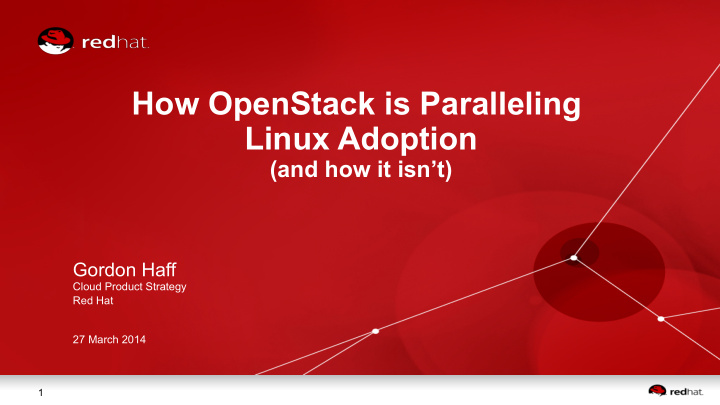



How OpenStack is Paralleling Linux Adoption (and how it isn’t) Gordon Haff Cloud Product Strategy Red Hat 27 March 2014 1
About Me • Red Hat Cloud Product Strategy • Twitter: @ghaff • Google+: Gordon Haff • Email: ghaff@redhat.com • Blog: http://bitmason.blogspot.com • Formerly: Illuminata (industry analyst), Data General (minicomputers/Unix/NUMA/etc.) 2
A tale of two projects 3
Linux was part and parcel of new computing wave Linux came of age during the Internet infrastructure build-out Transitions create opportunities Transitions require new approaches Source: Hobbes Internet timeline 4
OpenStack is as well By 2020… 40% of the industry's revenue and 98% of its growth will be driven by 3rd Platform technologies that today represent just 22% of ICT spending. IDC, 2013 5
But environment then much different 6
From today …mainstream IT organizations cannot ignore the influence and presence of OSS in their technology road maps... Those that do so place themselves at risk for technical and legal nightmare scenarios and/or miss out on significant competitive business value. Gartner, Hype Cycle for Open-Source Software, 2013 7
Open source 1990-2005: Commoditization • Innovation on the development and business models • Breaking down vertical stacks • Linux (specifically) enabled cross-platform *nix • Democratizing access • “Good enough” replacements for expensive and proprietary 8
Open source 2005-2015: Innovation* *YMMV depending upon workload type 9
Adoption happens at uneven rates The future has arrived — It’s just not evenly distributed yet. William Gibson Credit: Gonzo Bonzo, Wikimedia Commons 10
Adoption differs by industry and geography Credit: Wikimedia based on Geoffrey Moore’s technology adoption lifecycle 11
Adoption differs by workload “Pets” “Farm animals” a.k.a. traditional workloads a.k.a. cloud workloads • rover.redhat.com • piggie142.redhat.com • Unique snowflakes • Almost identical • Nurse back to health • Simply replace Credit: Tim Bell at CERN, Bill Baker at Microsoft, & others 12
Widespread adoption isn’t immediate 13
OpenStack is only 4ish years old Sept 2012: OpenStack July 2010: Foundation Nov 2010: OpenStack launches. Folsom 1 st design launches release. summit Oct 2010: Sept 2011: Oct 2013: Austin Diablo Havana code release release. release 14
Richness of community matters % Changes to Linux Kernel 2007-2012 Source: Linux Foundation, March 2012 15
Commits in the OpenStack Havana release Source: Bitergia 16
But also differences • Governance • (Initial) motivation • Licensing • Structure of project 17
A Trend Towards Permissive Licensing • Proven success of development model • Commercialization • Increased emphasis on communities Source: Donnie Berkholz, RedMonk, April 2013 18
Governance less understood than licenses Source: http://www.visionmobile.com/blog/2009/08/open-is-the-new-closed/ 19
Commercial distributions aid business consumption 20
Linux complements and ecosystem • Open source projects • ISV certifications • Hardware certifications • Device drivers • Training and education • Commercialization & support • Consulting 21
OpenStack is similar • Host & guest operating systems • Platform-as-a-Service • Cloud management platform • Hardware enablement and certifications • Training and education • Commercialization & support • Consulting 22
Takeaways • Transitions create opportunities • Don’t expect overnight perfection • Community matters • Governance matters (but it’s complicated) • Consumability matters • Ecosystem matters 23
Is it true that: Happy open source projects are all alike; every unhappy open source project is unhappy in its own way? 24
QUE QUESTIONS ONS & LE LEARN N MOR ORE MY INFO Twitter: @ghaff Google+: Gordon Haff Email: ghaff@redhat.com Blog: http://bitmason.blogspot.com 25
Recommend
More recommend